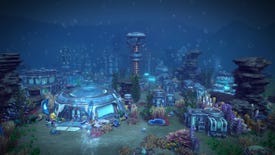Aquatico review: a soothing underwater city builder that neglects the dangers of the deep
Rapture 2.0
There’s nothing like the ocean when it comes to perilous beauty. Every breathtaking thing down there, from jellyfish to giant squids to killer whales, either wants to kill you (see killer whales) or is so frigidly indifferent to human existence that it might as well want you dead. After all, you might be able to scare off a predator, but there’s no negotiating with an ocean current.
Aquatico promises city-building enthusiasts a deep dive into this nearly untapped environ (nearly untapped, I’ll get into that later) but while this game delivers on the ocean’s beauty, it’s disappointingly light on peril.
The game begins with a quick splash of post-apocalyptic narrative – life on the surface was awesome until it took a giant meteor to the face – before plunging players into a comprehensive tutorial about the various infrastructure you need to build to provide power, oxygen, and other essentials to your tiny team of scientists on the ocean floor. In order to succeed as sea-mayor, you’re told, you must battle the elements, explore the ocean floor on daring expeditions, and introduce new policies to keep your city happy, productive, and breathing. However, the reality of deep-sea living is less 'swimming against an unforgiving tide' and more 'lukewarm bath.'
It’s the "survival" part of “survival city builder” where Aquatico flounders. In order for a city builder to reel me in, it needs to do two things: challenge me and make me care. Frostpunk is the obvious example of a city-builder game that does both of these things right. Every time you place a new building, send out a scouting party, or tap a new resource, it’s a make-or-break decision that has the potential to plunge your city into frozen darkness and the unique narrative stakes introduced in each campaign imbue each choice with additional weight and meaning.
.jpg?width=690&quality=80&format=jpg&auto=webp)
The version of Aquatico I had access to only has one difficulty mode: normal. Managing the game’s interlocking production chains provides a pleasing puzzle, but once I set up basic fuel and food supply systems, all sense of threat from the environment evaporated, leaving little reason to progress other than the fact that, well, I guess I’m supposed to because I’m playing a game.
Just to see where the line was, I actually put this to the test: I was able to sit on my fins doing absolutely nothing for an entire in-game year–including willfully denying my population access to a clinic despite numerous alerts gently suggesting I provide them healthcare–without any consequences at all. A survival game should definitely punish you for that, but, despite happiness being presented as a key metric for a city’s success in Aquatico, my workers’ satisfaction levels never dipped below 99/100 no matter how far I went out of my way to neglect them.
"Fortunately, Aquatico comes equipped with a built-in stress-relief system: a pristine ocean teeming with maritime life"
Much of the UI for displaying these levels alongside resources, job assignments, and other information is reminiscent of Banished, in that it could do with some streamlining. Stats on every single resource, job role, and building you might eventually have access to are presented all at once and the ability to open multiple windows only multiples the potential for overwhelm. On the other hand, some basic stats – like a simple food produced/consumed calculation – aren’t available, leaving players to do the math themselves. It’s useable, but often provides too much information without offering the info you’re actually looking for. The expedition process is similarly finicky but functional and can net you some cool resources like cider and uranium, though I never got around to using them.
.jpg?width=690&quality=80&format=jpg&auto=webp)
.jpg?width=690&quality=80&format=jpg&auto=webp)
.jpg?width=690&quality=80&format=jpg&auto=webp)
Fortunately, Aquatico comes equipped with a built-in stress-relief system: a pristine ocean teeming with maritime life. While your base expands along the ocean floor, adding plastic production plants, sea cucumber farms, and air-filled domes packed with tiny homes, the seaweed sways and schools of manta rays flit by, seemingly unaffected by the introduction of unmitigated fossil fuel extraction to their environment. Those are some chill vibes. It’s like an aquarium screensaver on steroids. I couldn’t begin to tell you if Aquatico has a full soundtrack or is just playing the same zen-yet-optimistic tune on loop, but it’s a good time.
Watching majestic sea life swim by your city becomes a main pass time purely because Aquatico also has no campaigns, but it definitely needs them – and I know this because I’ve played this game before: It’s called Deep Sea Tycoon. DST, released in the early 2000s, is basically Aquatico with chunkier neon graphics, grating music, and a way simpler production system. It’s an all-around “worse” game but I poured way more hours into it as a kid than I ever will Aquatico because 1) my standards were obviously way lower back then and 2) its campaign missions gave players something to do.
Aquatico doesn’t. Despite starting you out with just four workers, the player’s relationship with your city’s residents isn’t personal enough to support the do-it-yourself storytelling of a game like RimWorld. If anything, the small scale of your city’s population sort of undermines Aquatico’s only narrative assertion–a dome housing a dozen or so unemployed people over a period of years isn’t really a city, it’s more of an incredibly resource-intensive deep sea bunker for a handful of idle elites. Don’t get me wrong, I’m totally up for playing Deep Sea Bunker Simulator, but having players construct higher-density housing like apartments or suburb blocks instead of individual bubble homes might help create the sense of scale necessary to feel like you’re sea-mayor of a city and not just a culdesac.
.jpg?width=690&quality=80&format=jpg&auto=webp)
Without narrative restraints on which resources are available or what goals your city should pursue (say, ecology versus mineral extraction versus discovering some deep sea mystery), there is only ever a single correct answer to the question of “what should I do next?” That answer is “unlock whatever the next branch on the research tree is and build that thing”–which is fine during your first play-through when you’re seeing all the technologies and their associated buildings with fresh eyes, but doesn’t provide much replay value. There are multiple maps you can choose from, but all that really offers is the opportunity to follow the same exact technology progression in a slightly different location.
"The most interesting aspect of Aquatico by far is the extent to which your city relies on automation"
There are some intriguing glimmers in the deep dark, however – the glow of an anglerfish’s lure, perhaps? The most interesting aspect of Aquatico by far is the extent to which your city relies on automation. Almost everything except a handful of more “artisanal” tasks like tailoring, doctoring, and, for some reason, shark fighting, is done by drones.
While many resource management games include automation as an unlockable perk that can free up some of your beleaguered human workers, in Aquatico the real struggle is finding something–anything!–for your humans to do. In the early game, drones haul your resources, harvest food, and operate your factories while your human workers stand idle, 100% satisfied just staring out into the ocean from inside of their reverse-fish bowl. HQ continues sending new recruits to assist with your “daily tasks,” but you barely have any because professions, like everything else, are buried deep in the research tree behind seemingly unrelated prerequisites.
.jpg?width=690&quality=80&format=jpg&auto=webp)
Several years into the game, less than half of my population is even employed. Now, there’s not necessarily anything wrong with that on a conceptual level. It’s exciting to imagine a solarpunk – or in this case, wavepunk – society in which automation has been effectively harnessed to free humans from dull and dangerous tasks while providing the basic resources necessary to support creative, fulfilling lives in thriving communities.
It isn’t really possible to realize that vision in Aquatico, though. All I want to do is build my pixel people an endless garden of lush prosperity full of dogs and sushi, but is paradise really worth anything if they’re just as happy pacing around a barren metal dome?
Maybe Aquatico is more satisfying on higher difficulty levels and maybe campaigns will be introduced in future updates (though I haven’t found anything from the developers indicating that is the case). All I can do, though, is review the game in front of me: it’s pretty but lifeless.












